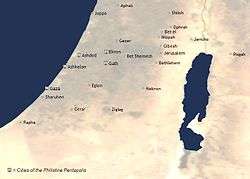Philistia
| Philistia (Biblical pentapolis) | ||||||||||
| ||||||||||
 | ||||||||||
| Capital | Not specified | |||||||||
| Languages | Philistine language, Canaanite language, Hebrew language | |||||||||
| Religion | Canaanite religion | |||||||||
| Demonym | Philistine | |||||||||
| Government | Federation | |||||||||
| Historical era | Iron Age | |||||||||
| • | Late Bronze Age collapse | 1175 BC | ||||||||
| • | Assyrian conquest of the Levant | 722 BC | ||||||||
| ||||||||||
Philistia (Hebrew: פלשת, Pleshet) was, according to Joshua 13:3 and 1 Samuel 6:17, a Pentapolis in south-western Levant, comprising Ashkelon, Ashdod, Ekron, Gath, and Gaza. The Philistines or Peleset (not to be confused with modern Palestinian Arabs) were believed to be Indo-European[1] speaking invaders to the region, arriving either from Crete and the Aegean or western Anatolia during the Bronze Age Collapse.[2]
The Pentapolis is described in the Hebrew Bible as being in constant struggle and interaction with the neighbouring Israelites, Canaanites and Egyptians, being gradually absorbed into the Canaanite culture.[3] Philistia ruled major parts of southern Canaan at the peak of its expansion, but was eventually conquered and subdued by neighbouring Israelites.[4]
The Philistines were not mentioned following the conquest of the Levant by the Neo-Assyrian Empire (911-605 BC).
East of Gaza

The area east of Gaza, particularly around Nahal Besor brook that reaches into the hills as far as Beersheva had very substantial Philistine occupation. This area is a part of Negev desert. It also includes the Nahal Gerar brook to the north that joins Nahal Besor before the stream flows into the Mediterranean.[5]
This was a heavily populated area during the early Iron Age. It includes sites such as Tell Beit Mirsim, Tel Haror, Tel Sera (Ziklag) along the Nahal Gerar, and Tel Gamma and Tell el-Farah (South) along the Nahal Besor.[6] All these sites and others in the area had Philistine settlements.[7]
As far as the Neo-Assyrian policy goes, when they first invaded this area, they gave the Philistine cities considerable autonomy in exchange for tribute. But later, while responding to various revolts, their policy hardened.[8]
Kings
- Achish the king of Gath
See also
- Philistines
- Palistin (or Walistin), a Syro-Hittite kingdom (11th-9th c. BC) in what is now NW Syria and the SE Turkish province of Hatay
References
- ↑ Rabin 1963, pp. 113–139.
- ↑ http://news.nationalgeographic.com/2016/07/bible-philistine-israelite-israel-ashkelon-discovery-burial-archaeology-sea-peoples/
- ↑ Library, National Public. "Philistia | National Public Library - eBooks | Read eBooks online". nationalpubliclibrary.info. Retrieved 2016-11-01.
- ↑ Library, National Public. "Philistia | National Public Library - eBooks | Read eBooks online". nationalpubliclibrary.info. Retrieved 2016-11-01.
- ↑ David Ben-Shlomo, Tell Jemmeh, Philistia and the Neo-Assyrian Empire during the Late Iron Age. Levant 2014; 46(1), 58-88 doi:10.1179/0075891413Z.00000000031
- ↑ Gunnar Lehmann, Steven A. Rosen, Angelika Berlejung, Bat-Ami Neumeier and Hermann M. Niemann, Excavations at Qubur al-Walaydah, 2007–2009 academia.edu
- ↑ "Tell el-Far'ah, South -- Israel Excavation Project Website". Farahsouth.cgu.edu. Retrieved 12 Jan 2016.
- ↑ David Ben-Shlomo, Tell Jemmeh, Philistia and the Neo-Assyrian Empire during the Late Iron Age. Levant 2014; 46(1), 58-88 doi:10.1179/0075891413Z.00000000031